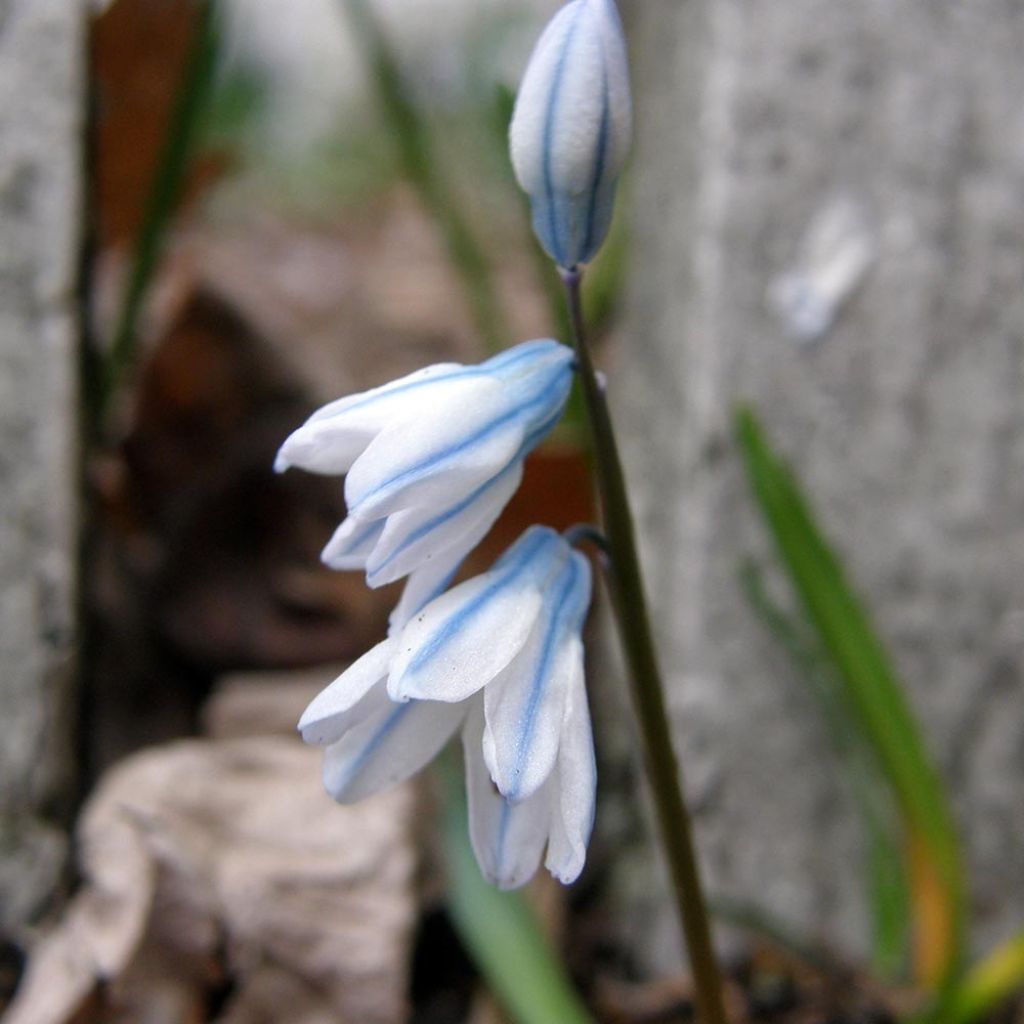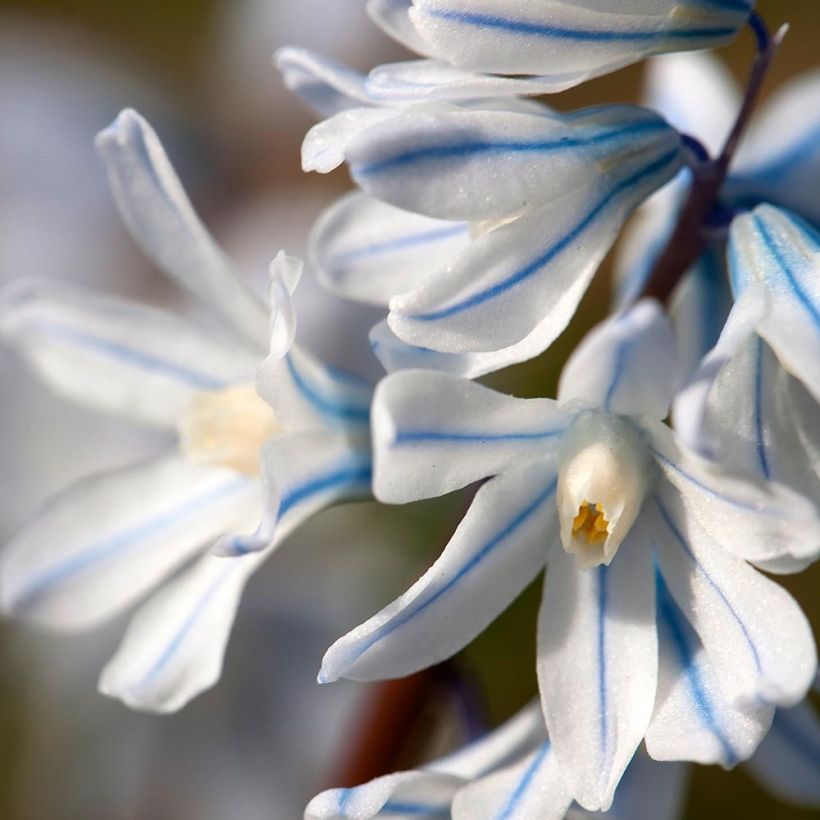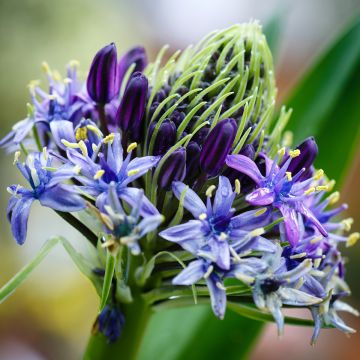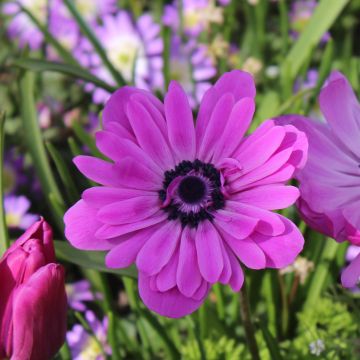

Scille mischtschenkoana Tubergeniana


Scille mischtschenkoana Tubergeniana


Scille mischtschenkoana Tubergeniana


Scille tubergeniana
Scilla mischtschenkoana 'Tubergeniana'
Scilla mischtschenkoana Tubergeniana
This plant carries a 6 months recovery warranty
More information
We guarantee the quality of our plants for a full growing cycle, and will replace at our expense any plant that fails to recover under normal climatic and planting conditions.
From €5.90 for pickup delivery and €6.90 for home delivery
Express home delivery from €8.90.


Does this plant fit my garden?
Set up your Plantfit profile →
Description
Scilla mischtschenkoana 'Tubergeniana' is a little-known Scilla that deserves to be planted more in our rock gardens, for its precious pale porcelain blue flowers, so eager to appear in late winter. This small bulbous plant develops floral and compact spikes often before the emergence of its ribbon-like foliage, which disappears in summer. Easy to grow in the sun in any well-drained soil, even dry in summer, it naturalizes easily in the company of other small spring bulbs.
Scilla mischtschenkoana, from the Asparagaceae family, is a plant native to the southern Caucasus, southern Russia, and northern Iran, regions governed by rather cold winters and often very dry summers. The 'Tubergeniana' cultivar, very similar to this wild species, is said to be more cold-resistant or taller according to some sources. Both have been awarded by the Royal Horticultural Society in England. The plant, a perennial, grows from a small bulb. Flowering occurs in February-March, when the foliage just emerges from the ground. A floral stem rises from the ground up to 15cm (6in), bearing 2 to 5 campanulate flowers with 6 petals, 2cm (1in) in diameter, with an iridescent texture. Each petal, of varying white-blue color, is crossed by a more intense blue central line. This flowering is slightly fragrant. The foliage then unfolds, showing 2-3 leaves per bulb. The leaves are ribbon-like, thick and narrow, 10-15cm (4-6in) long, glossy and dark green. The foliage will more or less disappear in summer as the plant enters dormancy. This scilla spreads by producing bulblets, but also by sowing.
With their beautiful porcelain blue flowers, 'Tubergeniana' Scillas arrive just at the end of the snowdrop flowering and just before Siberian squills. They form beautiful carpets of a very soft blue that can be naturalized under deciduous trees, in a lightly trodden and lightly mowed short grass meadow, along a path or in a sunny rock garden to be able to contemplate them at leisure from the end of winter. Associate them with other small bulbs that won't suffocate them: botanical crocuses, reticulated irises, blanda anemones, Cyclamen coum, Colchicums, botanical tulips...
Sold in packs of 15 bulbs, size 7.
Report an error about the product description
Scilla mischtschenkoana 'Tubergeniana' in pictures


Plant habit
Flowering
Foliage
Botanical data
Scilla
mischtschenkoana
Tubergeniana
Hyacinthaceae
Caucasus
Other Scilla
Planting and care
This Scilla is grown in the sun in cold regions, but rather at the base of deciduous trees and bushes in our hot and sunny regions. Plant the bulbs in groups of 7 to 14, in any well-drained garden soil, even dry in summer. Very compact and wet soils in winter should be avoided. Bury the bulbs at a depth of 4-5cm (2in). Avoid moving the plants, as they will multiply by producing bulblets as well as by sowing. You can divide the clumps in summer, during the bulb's resting period.
Planting period
Intended location
Care
-
, onOrder confirmed
Reply from on Promesse de fleurs
Small Spring Bulbs
Haven't found what you were looking for?
Hardiness is the lowest winter temperature a plant can endure without suffering serious damage or even dying. However, hardiness is affected by location (a sheltered area, such as a patio), protection (winter cover) and soil type (hardiness is improved by well-drained soil).

Photo Sharing Terms & Conditions
In order to encourage gardeners to interact and share their experiences, Promesse de fleurs offers various media enabling content to be uploaded onto its Site - in particular via the ‘Photo sharing’ module.
The User agrees to refrain from:
- Posting any content that is illegal, prejudicial, insulting, racist, inciteful to hatred, revisionist, contrary to public decency, that infringes on privacy or on the privacy rights of third parties, in particular the publicity rights of persons and goods, intellectual property rights, or the right to privacy.
- Submitting content on behalf of a third party;
- Impersonate the identity of a third party and/or publish any personal information about a third party;
In general, the User undertakes to refrain from any unethical behaviour.
All Content (in particular text, comments, files, images, photos, videos, creative works, etc.), which may be subject to property or intellectual property rights, image or other private rights, shall remain the property of the User, subject to the limited rights granted by the terms of the licence granted by Promesse de fleurs as stated below. Users are at liberty to publish or not to publish such Content on the Site, notably via the ‘Photo Sharing’ facility, and accept that this Content shall be made public and freely accessible, notably on the Internet.
Users further acknowledge, undertake to have ,and guarantee that they hold all necessary rights and permissions to publish such material on the Site, in particular with regard to the legislation in force pertaining to any privacy, property, intellectual property, image, or contractual rights, or rights of any other nature. By publishing such Content on the Site, Users acknowledge accepting full liability as publishers of the Content within the meaning of the law, and grant Promesse de fleurs, free of charge, an inclusive, worldwide licence for the said Content for the entire duration of its publication, including all reproduction, representation, up/downloading, displaying, performing, transmission, and storage rights.
Users also grant permission for their name to be linked to the Content and accept that this link may not always be made available.
By engaging in posting material, Users consent to their Content becoming automatically accessible on the Internet, in particular on other sites and/or blogs and/or web pages of the Promesse de fleurs site, including in particular social pages and the Promesse de fleurs catalogue.
Users may secure the removal of entrusted content free of charge by issuing a simple request via our contact form.
The flowering period indicated on our website applies to countries and regions located in USDA zone 8 (France, the United Kingdom, Ireland, the Netherlands, etc.)
It will vary according to where you live:
- In zones 9 to 10 (Italy, Spain, Greece, etc.), flowering will occur about 2 to 4 weeks earlier.
- In zones 6 to 7 (Germany, Poland, Slovenia, and lower mountainous regions), flowering will be delayed by 2 to 3 weeks.
- In zone 5 (Central Europe, Scandinavia), blooming will be delayed by 3 to 5 weeks.
In temperate climates, pruning of spring-flowering shrubs (forsythia, spireas, etc.) should be done just after flowering.
Pruning of summer-flowering shrubs (Indian Lilac, Perovskia, etc.) can be done in winter or spring.
In cold regions as well as with frost-sensitive plants, avoid pruning too early when severe frosts may still occur.
The planting period indicated on our website applies to countries and regions located in USDA zone 8 (France, United Kingdom, Ireland, Netherlands).
It will vary according to where you live:
- In Mediterranean zones (Marseille, Madrid, Milan, etc.), autumn and winter are the best planting periods.
- In continental zones (Strasbourg, Munich, Vienna, etc.), delay planting by 2 to 3 weeks in spring and bring it forward by 2 to 4 weeks in autumn.
- In mountainous regions (the Alps, Pyrenees, Carpathians, etc.), it is best to plant in late spring (May-June) or late summer (August-September).
The harvesting period indicated on our website applies to countries and regions in USDA zone 8 (France, England, Ireland, the Netherlands).
In colder areas (Scandinavia, Poland, Austria...) fruit and vegetable harvests are likely to be delayed by 3-4 weeks.
In warmer areas (Italy, Spain, Greece, etc.), harvesting will probably take place earlier, depending on weather conditions.
The sowing periods indicated on our website apply to countries and regions within USDA Zone 8 (France, UK, Ireland, Netherlands).
In colder areas (Scandinavia, Poland, Austria...), delay any outdoor sowing by 3-4 weeks, or sow under glass.
In warmer climes (Italy, Spain, Greece, etc.), bring outdoor sowing forward by a few weeks.











































